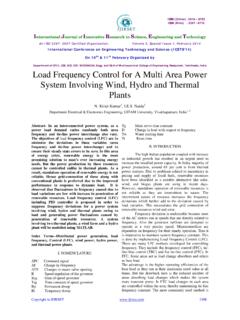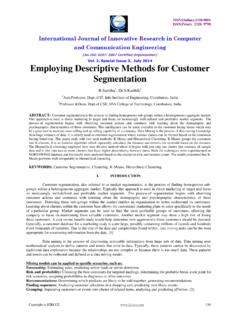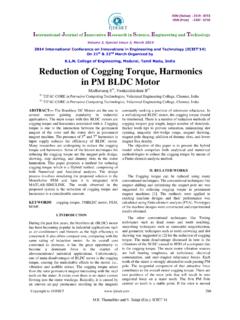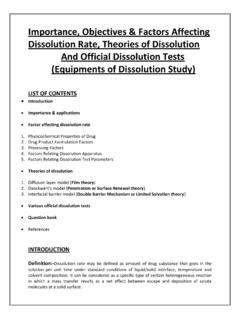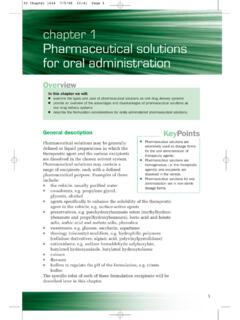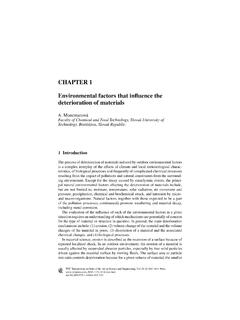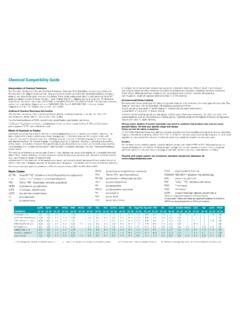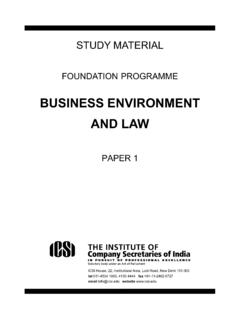Transcription of Excipients used in the Formulation of Tablets
1 Research and Reviews: Journal of Chemistry 143 e-ISSN: 2319-9849 p-ISSN: 2322-00 RRJCHEM | Volume 5 | Issue 2 | June 2016 Excipients used in the Formulation of Tablets Karthik Varma V* Department of Pharmaceutical Analysis, Vikas college of pharmaceutical Sciences, Jawaharlal Nehru technological University, Suryapet, Nalgonda, Telangana, India, E-mail: Research Article Received: 07/07/2016 Revised: 26/07/2016 Accepted: 31/07/2016 *For Correspondence Department of Pharmaceutical Analysis, Vikas college of pharmaceutical Sciences, Jawaharlal Nehru technological University, Suryapet, Nalgonda, Telangana, India, E-mail: Keywords: Excipients ; Bioavailability; Diluents: Binders; Super disintegrants ABSTRACT Excipients are additive substances used in tablet Formulation to improve bulkiness, disintegration, dissolution rate and bioavailability of the drug.
2 The drug and excipient interaction study is carried using Infrared Spectrum to know the stability of Excipients and drug. INTRODUCTION Excipients are inert substances used as diluents or vehicles for a drug. In the pharmaceutical industry it is a catch-all term which includes various sub-groups comprising diluents or fillers [1-9], binders or adhesives, disintegrants, lubricants, glidant, flavors, colors and sweeteners. All of these must meet certain criteria as follows [10-20]: a) Physiologically inert. b) Acceptable to regulatory agencies. c) Physiologically and chemically stable. d) Free from bacteria. e) Should not interfere with the bioavailability of the drug.
3 F) Commercially available in the form and purity commensurate to pharmaceutical standards. g) Low cost, inexpensive. h) Meet the standards of regulatory requirements. To assure that no excipient interferences with the utilization of the drug, the formulator must carefully and critically evaluate combinations of the drug with each of the contemplated Excipients and must as certain compliance of each ingredient with existing standards and regulations. The screening of drug-excipient and excipient-excipient interactions carried out in pre Formulation studies [21-30]. List of Excipients [31-40] Diluents: Diluents are fillers used to make up the volume of tablet if tablet is inadequate to produce the volume.
4 Diluents used as disintegrants in dispersible and orally disintegrating tablet. Example: Lactose, Spray dried lactose, Micro crystalline cellulose (Avicel 101 and 102), Pvpk30 (Pearlitol SD200 and 25C), Sorbitol, Dibasic calcium phosphate dehydrate, Calcium sulphate dehydrate etc. Research and Reviews: Journal of Chemistry 144 e-ISSN: 2319-9849 p-ISSN: 2322-00 RRJCHEM | Volume 5 | Issue 2 | June 2016 Binders: Binders are used as binding agent in Tablets ; it provides cohesive strength to powdered materials. Binders are added in both dry and wet form to form granules. Example: Gelatin, glucose, Lactose, cellulose derivatives-Methyl cellulose, Ethyl cellulose, Hydroxy propylmethyl cellulose,Hydroxy propyl cellulose, starch, Poly vinyl pyrrolidone (Povidone), Sodium alginate, Carboxymethylcellulose, Acacia etc.
5 Lubricants: Used to reduce the friction between die wall and tablet, prevent adhesion of tablet to dies and punches. Helps in easy ejection of Tablets from die cavity. Classified in to 2 types. Example: Insoluble- Stearic acid, Magnesium stearate, Calcium stearate, Talc, Paraffin. Soluble- Sodium lauryl sulphate, Sodium benzoate, PEG 400, 600,8000 etc. Glidants: Helps in free flowing of granules from hopper to die cavity. Minimize friction between particles. Example: Colloidal Silicon dioxide (Aerosil), Cornstarch, Talc etc. Anti-adherents: These are added to prevent adhesion of tablet material to punches and dies. Example: Talc Anti-adherent: Prevent sticking of tablet to dies and punches.
6 Superdisintegrants: When they come in contact with water in oral cavity/GIT break down in to small particles. Example: Croscarmellose sodium (Ac-di-sol),Crospovidone (Polyplasdone), and Sodium starch glycollate, Starch etc. Role of Super disintegrants in the manufacturing of Tablets Disintegrating agents are substances included in tablet formulations and in some hard shell capsule formulations to promote moisture penetration and dispersion of the matrix of the dosage form in dissolution fluids. An oral solid dosage form should ideally disperse into the primary particles from which it was prepared. Although various compounds have been proposed and evaluated as disintegrants, relatively few are in common usage today.
7 Traditionally, starch has been the disintegrant of choice in tablet formulations, and it is still widely used. For instance, starch generally has to be present at levels greater than 5% to adversely affect compactibility, especially in direct compression. Moreover, intra granular starch in wet granulations is not as effective as dry starch [41-50]. Characteristics of disintegrant The ideal disintegrant should have the following characteristics: Poor solubility Poor gel formation Good hydration capacity Good compressibility and flow properties No tendency to form complexes with the drugs factors affecting action of disintegrants Percentage of disintegrants present in the Tablets .
8 Types of substances present in the Tablets . Combination of disintegrants. Presence of surfactants. Hardness of the Tablets . Nature of Drug substances. Research and Reviews: Journal of Chemistry 145 e-ISSN: 2319-9849 p-ISSN: 2322-00 RRJCHEM | Volume 5 | Issue 2 | June 2016 Mixing and Screening. Classification of Superdisintegrants 1. Modified starches (Sodium starch glycolate, NF) Description: Sodium carboxy methyl starch; the carboxy methyl groups induces hydrophilicity and cross-linking reduces solubility. Trade name: Explotab (Edward Mendell Co.), Primojel Generichem Corp.), Tablo (Blanver, Brazil) 2. Modified cellulose (Croscarmellose, NF) Description: Sodium carboxymethyl cellulose which has been cross-linked to render the material insoluble.
9 Trade name: AcDiSol (FMC Corp.), Nymcel ZSX (Nyma, Netherlands), Primellose (Avebe, Netherlands) 3. Cross-linked poly-vinyl pyrrolidone (Crospovidone, NF) Description: Cross-linked poly vinyl pyrrolidone; cross-linking render the material insoluble in water. Trade name: Crospovidone M (BASF Corp.), Kollidon CL (BASF Corp.) 4. Excipient profiles PVP K30 Synonyms: E1201; Kollidon; Plasdone; poly [1-(2-oxo-1-pyrrolidinyl)ethylene]; polyvidone; polyvinylpyrrolidone; PVP; 1-vinyl-2-pyrrolidinone polymer. Chemical Name and CAS Registry Number: 1-Ethenyl-2-pyrrolidinone homopolymer (9003-39-8) Empirical Formula: (C6H9NO)n Structural Formula: Functional Category: Disintegrant; dissolution aid; suspending agent; tablet binder.
10 Applications: Binders in wet granulation processes, coating agents suspending, stabilizing, or viscosity-increasing agent. Typical Properties: Acidity/alkalinity: pH = (5% w/v aqueous solution). Density (bulk): g/cm3 for Plasdone. Density (tapped): g/cm3 for Plasdone. Density (true): g/cm3 Flowability: 20 g/s for povidone K-15;16 g/s for povidone K-29/32. Research and Reviews: Journal of Chemistry 146 e-ISSN: 2319-9849 p-ISSN: 2322-00 RRJCHEM | Volume 5 | Issue 2 | June 2016 Melting point: Softens at 1500C. Moisture content: Hygroscopic. Solubility Freely soluble in acids, chloroform, ethanol (95%), ketones, methanol, and water; practically insoluble in ether, hydrocarbons, and mineral oil.
